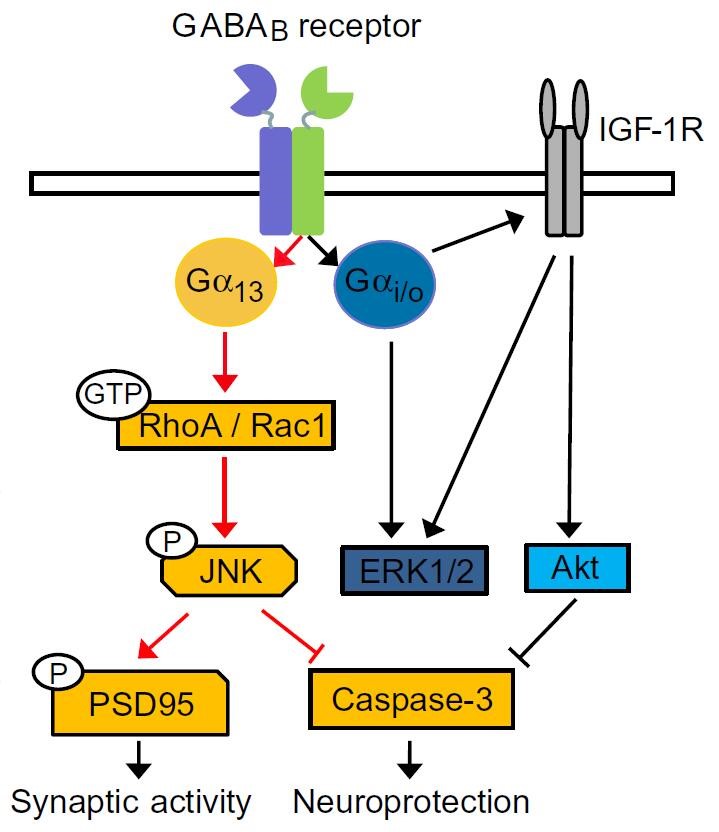On October 19, 2021, a sub-issue of Science--Science Signaling published online the latest scientific research of Professor Liu Jianfeng's team from the School of Life Sciences and Technology of Huazhong University of Science and Technology, entitled "The GABAB receptor mediates neuroprotection by coupling to G13".
G protein-coupled receptors (GPCRs) are the largest family of membrane proteins in human, play a crucial role in cell signal transduction and are closely related to various diseases. It is known that GPCRs activate MAPK signaling through different G proteins or β-arrestin to regulate a series of physiological functions. Therefore, they are important targets for drug development. More than 40% of marketed drugs are developed based on GPCR targets. Type B γ-aminobutyric acid receptors (GABAB receptors), belong to Class C of GPCRs, are widely distributed in the pre- and post-synaptic membranes, which mediate long-term inhibitory synaptic activities in turn to regulate different functions. Previous studies have reported that baclofen, a specific agonist of GABAB receptors, is used to relieve spasm and alcohol addiction. Moreover, the dysfunction of GABAB receptor is associated with various mental diseases, such as epilepsy, depression, anxiety, mental retardation, and Alzheimer's disease. All these indicate that the GABAB receptor is a very important and promising drug target.
Professor Liu Jianfeng's team has been long engaged in the studies of structure and functions of GABAB receptors, and conducted systematic and in-depth research on structure, rearrangement of active conformation, G protein-coupling modes and signaling pathway about GABAB receptors. Since 2019, Liu’s team has published articles on Nature, Nature Communication, Cell research and other journals to clarify the activation process of GABAB receptors (Nature Communication, 2019; Cell Research, 2020) and the unique mode of coupling to Gi (Nature, 2021). GABAB receptors coupling to Gi with flexible weak interactions. Whether GABAB receptor couple to other G proteins besides Gi/o is still unclear.
Professor Liu’s team continued the previous researches, and they further discovered that GABAB receptors can not only couple to Gi/o, but also activate G13 to regulate synaptic functions and neuroprotection through G13/JNK pathway in primary cultured neurons. These conclusions will help us better understand the functional diversity of GABAB receptors in the brain and provide new ideas for development of drugs targeting GABAB receptors. GABAB receptors activate different MAPK signaling pathways by coupling different G proteins, thereby play a neuroprotective effect through the synergy of G13/Rac1/JNK and Gi/o/IGF1R/Akt pathway. This suggests that for some specific GPCRs, two different signaling pathways are required to regulate their functions together, which is of vital guiding significance to better understand the functional diversity of GPCRs.

Figure: Schematic diagram of different G protein pathways induced by GABAB receptors
This work is another important achievement of Professor Liu Jianfeng's group in function and activation mechanism of GABAB receptors. It was completed by doctoral students Wang Yunyun and Gai Siyu from School of Life Sciences and technology of Huazhong University of Science and Technology, the Key Laboratory of Biophysics of the Education Department, and the International Joint Research Center of Perceptual Biotechnology of the Ministry of Science and Technology under the joint guidance of Professor Liu Jianfeng and Lecturer Xu Chanjuan. School of Life Science and Technology of Huazhong University of Science and Technology is the first corresponding unit for the thesis. This work was supported by the National Key Research and Development Program of the Ministry of Science and Technology, the National Natural Science Foundation of China, and the Program for Introducing Talents of Discipline to the Universities of the Ministry of Education.
Article link: https://pubmed.ncbi.nlm.nih.gov/34665640/